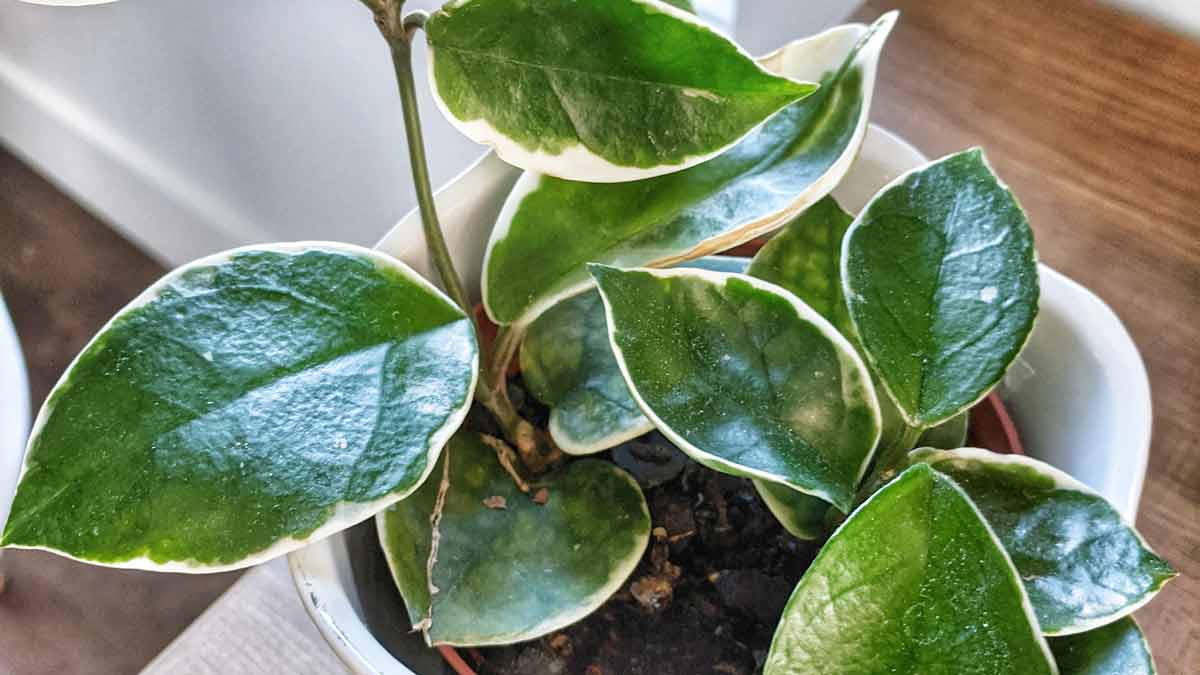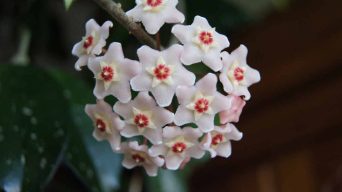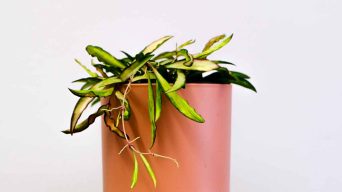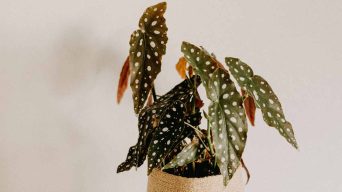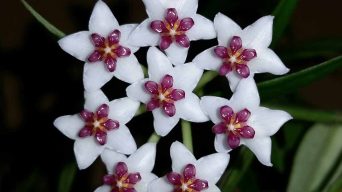Hoya plants are beautiful, easy-to-care-for houseplants that can brighten up any home.
They are tropical plants native to Asia, Australia, and the Pacific Islands.
Hoyas typically have large, waxy leaves and produce fragrant flowers.
Hoyas are generally low-maintenance plants, but they occasionally experience problems like their leaves falling off.
If you notice your hoya leaves falling off, don’t panic! In most cases, this issue can be resolved relatively quickly.
This article will discuss the possible reasons why hoya leaves may fall off and what you can do to fix the problem.
What Causes Hoya Leaves to Fall Off?
There are a few possible reasons why hoya leaves may fall off.
The most common reasons are:
1. Underwatering
One of the most common reasons hoya leaves fall off is because the plant is not getting enough water.
Hoyas must be watered regularly, about once a week or whenever the soil is dry.
If you water your hoya too little, the leaves will turn yellow and brown before falling off.
To avoid this, make sure to water your hoya regularly and check the soil before watering to ensure it is dry.
If you think your hoya is underwatered, try giving it a deep watering.
To do this, water the hoya plant until water starts to come out of the drainage holes at the bottom of the pot.
Let the hoya drain for a few hours, and then recheck the soil if it is still dry, water it again.
2. Overwatering
While underwatering is a common reason hoya leaves fall off, overwatering can also be to blame.
Hoyas do not like to sit in wet soil and will start to experience problems if they are overwatered.
The first sign of overwatering is usually yellow leaves. If the hoya is overwatered for too long, the leaves will start to brown and fall off.
To avoid overwatering your hoya, ensure the pot has drainage holes and that you only water the plant when the soil is dry to the touch.
It is also a good idea to water your hoya plant in the morning, so the plant has time to dry out before nightfall.
3. Temperature Stress
Another possible reason hoya leaves may fall off is because of temperature stress.
Hoyas are tropical plants and prefer warm temperatures.
They will start to experience problems if the temperature drops too low, particularly at night.
If your hoya plant is exposed to temperatures below 50 degrees Fahrenheit, the leaves will start to turn yellow and then brown before falling off.
To avoid temperature stress, ensure your hoya is not near any drafts or vents and that the temperature in the room stays above 50 degrees Fahrenheit, ideally between 60 and 80 degrees.
4. Nutrient Deficiencies
Hoyas can also experience problems if they are not getting the nutrients they need.
The most common nutrient deficiency in hoyas is a lack of nitrogen.
If your hoya is not getting enough nitrogen, the leaves will turn yellow before falling off.
To fix a nitrogen deficiency, you can fertilize your hoya with a nitrogen-rich fertilizer.
Make sure to follow the instructions on the fertilizer package and only fertilize your hoya every few months during the growing season to avoid overfertilizing.
5. Too Much Sunlight
Hoyas need bright indirect light to thrive, but too much sun can harm the plant.
If your hoya gets too much sun, the leaves will sunburn, displaying unsightly white spots, and then fall off.
To avoid this, place your hoya in an area that gets bright indirect light and does not receive direct sunlight for more than a few hours a day.
You can place your hoya near an east- or west-facing window. This will provide the hoya with the bright indirect light it needs without giving it too much direct sun.
6. Too Little Light
While too much sun can harm hoyas, too little light can cause problems.
If your hoya is not getting enough light, the leaves will start to turn yellow and then brown before falling off.
Hoyas need at least 4 hours of bright indirect light daily to thrive.
If your hoya is not getting enough light, try moving it to a brighter location, where it will receive more light each day.
7. Soil Issues
The soil your hoya is planted in can also affect the plant’s health.
Hoyas need well-draining soil that is rich in organic matter.
If the soil does not drain well, the hoya will start to experience problems with overwatering.
To fix this, you can try repotting your hoya into a pot with better drainage or adding perlite or sand to the existing soil to improve drainage.
If the soil is not rich in organic matter, the hoya will not be able to get the nutrients it needs and will start to experience nutrient deficiencies.
You can add compost or other organic matter to the soil to fix this.
8. Pest Infestation
Pests can also be to blame when hoya leaves start to fall off.
The most common pests that affect hoyas are aphids, mealybugs, and spider mites.
These pests suck the sap from the hoya leaves, causing the plant to weaken and the leaves to fall off.
To get rid of pests, you can use a pesticide or try horticultural oil or soapy water.
You can also try dipping a cotton swab in rubbing alcohol and applying it directly to the pests.
9. Diseases
Diseases are another possible reason hoya leaves may start to fall off.
The most common diseases that affect hoyas are root rot and leaf spot.
Root rot is caused by overwatering and can be fatal to hoyas.
If your hoya has root rot, the leaves will start to turn yellow and fall off.
Only water your hoya when the soil is dry to prevent root rot.
Leaf spot is a fungal disease that causes brown or black spots to form on hoya leaves.
If your hoya has leaf spot, you may notice the spots spreading and the leaves eventually falling off.
To prevent leaf spot, water your hoya regularly and make sure the leaves are dry before nightfall.
If your hoya does get leaf spot, remove the affected leaves and dispose of them properly. You can also try treating the plant with a natural fungicide.
10. Chemical Damage
Chemical damage is another possible reason hoya leaves may start to fall off.
This can be caused by using too much fertilizer or using the wrong type of fertilizer.
It can also be caused by pesticides or herbicides that are unsafe for hoyas.
Chemicals can also be in the water you use to water your hoya.
To prevent chemical damage, use the correct amount of fertilizer and only use pesticides or herbicides that are safe for hoyas.
You can also try distilled water to water your hoya, removing any chemicals from the water.
If you think your hoya is experiencing chemical damage, stop using the fertilizer, pesticide, or herbicide you use.
You can also try flushing the soil with water to remove residual chemicals. To do this, water your hoya deeply and then allow the water to drain completely.
Repeat this process a few times until you see the water running clear.
11. Transplanting Shock
Transplanting shock is another possible reason hoya leaves may start to fall off.
This can be caused by repotting your hoya too often or not acclimating your hoya to its new environment.
To prevent transplanting shock, only repot your hoya when it is necessary, and be sure to acclimate your hoya to its new environment properly.
If you think your hoya is experiencing transplanting shock, give it time to adjust to its new environment.
You can also try misting the leaves with water or using a humidity tray to help your hoya recover.
12. Natural Leaf Drop
Finally, it is essential to note that some hoya varieties shed their leaves naturally.
This is most common in hoyas grown as houseplants, such as Hoya carnosa and Hoya kerrii.
If your hoya is shedding its leaves naturally, there is no cause for concern.
You can tell if your hoya is shedding its leaves naturally if the lower leaves are falling off.
If your hoya is shedding its leaves naturally, there is no need to take action.
The hoya will eventually grow new leaves.
What To Do If Your Hoya Leaves Are Falling Off
If your hoya plant is dropping leaves, you can do a few things to fix the problem.
The following are some tips for what to do if your hoya leaves are falling off:
1. Check the Watering Schedule
One of the first things you should do if your hoya leaves are falling off is to check the watering schedule.
If you are watering your hoya too often, the roots may be soggy, which can cause the leaves to fall off.
On the other hand, the plant may be stressed if you are not watering your hoya enough, which can also cause the leaves to fall off.
To water your hoya correctly, water the plant deeply and then allow the soil to dry out completely before watering again.
2. Check the Soil
Another thing to do if your hoya leaves are falling off is to check the soil.
If the potting soil is too dense, it may not allow enough oxygen to reach the roots, which can cause the leaves to fall off.
You can try repotting your hoya into a lighter potting mix to fix this problem.
You can also try aerating the soil by poking holes with a fork or chopstick.
3. Check for Pests
Another thing to do if your hoya leaves are falling off is to check for pests.
If your hoya has pests, such as aphids, mealybugs, or spider mites, the plant may be stressed, which can cause the leaves to fall off.
You can try using a horticultural oil or insecticidal soap to eliminate pests.
You can also try wiping the pests off with a cotton swab dipped in rubbing alcohol.
4. Check for Diseases
Another thing to do if your hoya is dropping leaves is to check for diseases.
If your hoya has a disease, such as root rot or leaf spot, the plant may be stressed, which can cause the leaves to fall off.
You will need to use a fungicide or bactericide to treat a disease. A natural option is to use a milk and water solution.
To make this solution, mix 1 part milk with 9 parts water.
You also need to remove any affected leaves.
5. Check the Light
Another thing to do if your hoya leaves are falling off is to check the light.
If your hoya is not getting enough light, the plant may be stressed, which can cause the leaves to fall off.
You can try moving your hoya to a brighter location to fix this problem.
If you cannot move your hoya, use a grow light.
6. Check the Temperature
Another thing to do if your hoya leaves are falling off is to check the temperature.
If the temperature is too hot or too cold, the plant may be stressed, which can cause the leaves to fall off.
To fix this problem, you can try moving your hoya to a location with a more moderate temperature.
Ensure that the location is not in direct sunlight and that the temperature does not fluctuate too much.
7. Check the Humidity
Another thing to do if your hoya is dropping leaves is to check the humidity.
If the air is too dry, the plant may be stressed, which can cause the leaves to fall off.
You can try misting your hoya with water or using a humidifier to fix this problem.
You can also use a pebble tray.
To make a pebble tray, fill a tray with pebbles and water.
Place the tray under your hoya pot. This will help to increase the humidity around the plant.
8. Prune Your Hoya
If your hoya leaves are falling off, you may also want to prune the plant.
Pruning will help to remove any dead or dying leaves, which can help the plant to focus its energy on new growth.
To prune your hoya, use sharp, clean pruning shears.
Make sure to sterilize the shears before using them to prevent the spread of disease.
Start by removing any dead or dying leaves.
Then, remove any leaves that are yellowing or browning.
Finally, cut back any leggy or overgrown stems.
9. Fertilize Your Hoya
If your hoya leaves are falling off, you may also want to fertilize the plant.
Hoyas are light feeders, so you only need to fertilize them once or twice a year.
When fertilizing your hoya, use a weak fertilizer solution.
A good option is to use a half-strength, all-purpose fertilizer.
You can also use hoya-specific fertilizer, such as horticultural hoya feed.
Mix fertilizer with water according to the package directions to fertilize your hoya.
Then, water your hoya with the fertilizer solution.
10. Repot Your Hoya
If your hoya leaves are falling off, you may also want to repot the plant.
Repotting will help to refresh the soil mix and give your hoya a new lease on life.
When repotting your hoya, choose a pot that is only one size larger than the current pot.
Hoyas do not like to be pot-bound, so a pot that is too large can stress the plant.
It is also essential to choose a well-draining potting mix.
A good option is to use a hoya-specific potting mix.
To repot your hoya, remove the plant from its current pot.
Gently loosen the roots and replant in the new pot.
Don’t water the hoya for a few days after repotting to give the plant time to adjust.
What To Do With the Hoya Leaves That Fall Off?
Once you have determined the cause of the hoya leaves falling off and taken steps to fix the problem, you may wonder what to do with the fallen leaves.
The good news is that hoya leaves can be propagated.
To propagate hoya leaves, fill a pot with a well-draining potting mix.
Place the hoya leaves on top of the potting mix and mist with water.
Place the pot in a bright, indirect light spot and keep the potting mix moist.
The hoya leaves will eventually grow roots, and new plants will form.
You can then transplant the new plants into their own pots.
Final Thoughts
It’s normal for hoya leaves to fall off occasionally.
If it’s happening more frequently than usual, it could be a sign that your plant is stressed and needs some extra care.
Keep an eye on your hoya and take action if you see any other signs of stress, such as wilting leaves or stems.
With a little extra TLC, your hoya should be back to normal in no time!

